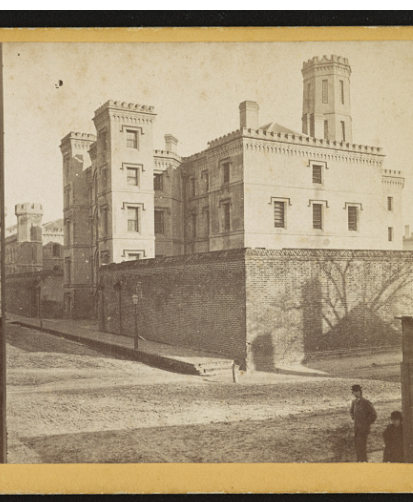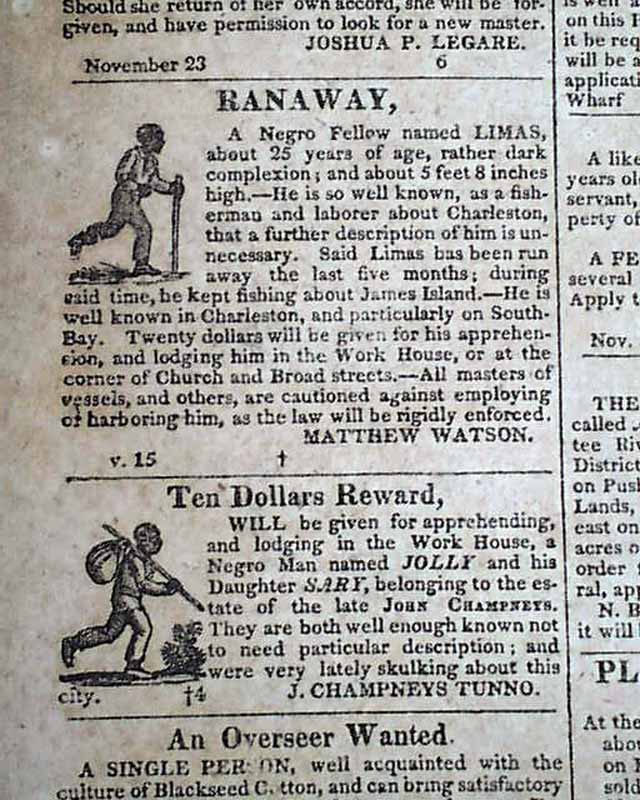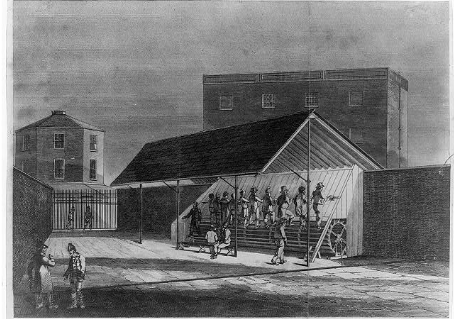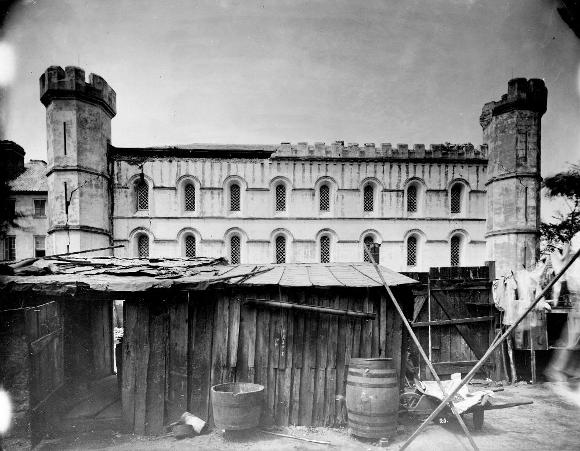THE WORK HOUSE

One of Charleston’s most awe-inspiring tourist attractions, especially for those who enjoy supernatural tales, is Charleston’s Old Jail on Magazine Street. From 1802 until 1939, it housed some of Charleston’s most notorious murderers and malefactors, as well as the enslaved and Union prisoners of war. Yet few visitors ever hear about the jail’s former companion building known as the Work House. Events that took place there are perhaps too unsettling for the tourist market.
The Work House, sometimes referred to as the Sugar House because of the site’s pre-1775 origins as a sugar factory, was where run-away, vagrant or unruly enslaved people were sent for discipline. Punishment here was brutal and varied. Floggings using various kinds of whips were common. For a 25-cents fee, slave owners could hire city workers to administer up to 20 lashes.
Given the opportunity, most enslaved victims chose flogging over the dreaded treadmill, a rotating paddle wheel used to grind corn, which was in use here by 1825. Slaves were forced to walk on the treadmill for eight hours a day, three minutes on and three minutes off. Exhausted, many were likely to fall and were often injured – or occasionally killed – in the mechanism.
After emancipation, the Work House served as a City Hospital, a rather odd rehabilitation choice as the building was dank, airless and open, with no place where those suffering contagious disease could be isolated from other patients. The white populace avoided the hospital whenever possible and most of its patients were indigent African Americans.
As Charlestonians’ world began to shake apart around 9:50 p.m. during the Great Earthquake of August 31, 1886, two of the hospital’s 125 patients were killed immediately by falling debris. An account in the Sept. 3 edition of the News and Courier notes that the hospital’s doors and shutters were used as stretchers to move patients to safety, noting: “They present a terrible spectacle. At the Hospital was also the body of a colored man, who was killed by a falling piazza, and the body of Mr. Robert Alexander, the young English analytical chemist, was … horribly mangled.”
The Work House was razed shortly after the quake and the lot where so many atrocities took place remains a mostly vacant and rarely interpreted parking lot.
Sidebar
EXCERPT FROM “RECOLLECTIONS OF SLAVERY BY A RUNAWAY SLAVE,” ATTRIBUTED TO JAMES MATTHEWS AS TOLD TO JOSHUA LEAVITT, EDITOR, THE EMANCIPATOR, SEPT. 30, 1838
“I have heard a great deal said about hell, and wicked places, but I don’t think there is any worse hell than that Sugar House. It’s as bad a place as can be… When you get in there, every way you look you can see paddles, and whips, and cowskins, and bluejays, and cat-o’-nine tails. The bluejay has two lashes, very heavy and full of knots. It is the worst thing to whip with of anything they have. It makes a hole where it strikes, and when they have done it will be all bloody… the paddle blisters and peels the skin all up…every time they hit with it, the skin peels off just the same as you peel a potato. You may hear the whip and paddle there, all hours in the day. There's no stopping. As soon as one is loosed from the rope, another is ready to be put in. Some days they have so many brought to be punished that they don't get through till late at night….”
This essay has been adapted from Lost Charleston and is included in the Lost Charleston Tour, Route 1. Sign up now!
One of Charleston’s most awe-inspiring tourist attractions, especially for those who enjoy supernatural tales, is Charleston’s Old City Jail on Magazine Street. From 1802 until 1939, it housed some of Charleston’s most notorious murderers and malefactors, as well as the enslaved and Union prisoners of war. Yet few visitors ever hear about the jail’s former companion building, known as the Work House. Events that took place there are perhaps too unsettling for the tourist market.
The Work House, sometimes referred to as the "Sugar House" because of the site’s pre-1775 origins as a sugar factory, was where run-away, vagrant or unruly enslaved people were sent for discipline. Punishment here was brutal and varied. Floggings using various kinds of whips were common. For 25 cents, slave owners could hire city workers to administer up to 20 lashes.
Given the opportunity, most victims chose flogging over the dreaded treadmill, a rotating paddle wheel used to grind corn, which was in use by 1825. Slaves were forced to walk on the treadmill for eight hours a day, three minutes on and three minutes off. Exhausted, many were likely to fall and were often injured – or occasionally killed – in the mechanism.
After emancipation, the Work House served as the City Hospital, a rather odd rehabilitation choice as the building was dank, airless and open, with no place where those suffering contagious disease could be isolated from other patients. The white populace avoided the hospital whenever possible; most of its patients were indigent African Americans.
As Charlestonians’ world began to shake apart around 9:51 p.m. during the Great Earthquake of August 31, 1886, two of the hospital’s 125 patients were killed immediately by falling debris. An account in the Sept. 3 edition of the News and Courier notes that the hospital’s doors and shutters were used as stretchers to move patients to safety, noting: “They present a terrible spectacle. At the Hospital was also the body of a colored man, who was killed by a falling piazza, and the body of Mr. Robert Alexander, the young English analytical chemist, was … horribly mangled.”
The Work House was razed shortly after the quake and the lot where so many atrocities took place today is a mostly vacant and rarely interpreted parking lot.
“I have heard a great deal said about hell, and wicked places, but I don’t think there is any worse hell than that Sugar House. It’s as bad a place as can be… When you get in there, every way you look you can see paddles, and whips, and cowskins, and bluejays, and cat-o’-nine tails. The bluejay has two lashes, very heavy and full of knots. It is the worst thing to whip with of anything they have. It makes a hole where it strikes, and when they have done it will be all bloody… the paddle blisters and peels the skin all up…every time they hit with it, the skin peels off just the same as you peel a potato. You may hear the whip and paddle there, all hours in the day. There's no stopping. As soon as one is loosed from the rope, another is ready to be put in. Some days they have so many brought to be punished that they don't get through till late at night….”



